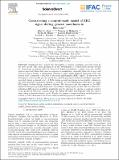Constructing a control-ready model of EEG signal during general anesthesia in humans
Author(s)
Abel, John H; Badgeley, Marcus A; Baum, Taylor E; Chakravarty, Sourish; Purdon, Patrick L; Brown, Emery N; ... Show more Show less
DownloadPublished version (1.076Mb)
Publisher with Creative Commons License
Publisher with Creative Commons License
Creative Commons Attribution
Terms of use
Metadata
Show full item recordAbstract
Significant effort toward the automation of general anesthesia has been made in the past decade. One open challenge is in the development of control-ready patient models for closed-loop anesthesia delivery. Standard depth-of-anesthesia tracking does not readily capture inter-individual differences in response to anesthetics, especially those due to age, and does not aim to predict a relationship between a control input (infused anesthetic dose) and system state (commonly, a function of electroencephalography (EEG) signal). In this work, we developed a control-ready patient model for closed-loop propofol-induced anesthesia using data recorded during a clinical study of EEG during general anesthesia in ten healthy volunteers. We used principal component analysis to identify the low-dimensional state-space in which EEG signal evolves during anesthesia delivery. We parameterized the response of the EEG signal to changes in propofol target-site concentration using logistic models. We note that inter-individual differences in anesthetic sensitivity may be captured by varying a constant cofactor of the predicted effect-site concentration. We linked the EEG dose-response with the control input using a pharmacokinetic model. Finally, we present a simple nonlinear model predictive control in silico demonstration of how such a closed-loop system would work.
Date issued
2020Department
Picower Institute for Learning and Memory; Massachusetts Institute of Technology. Department of Brain and Cognitive Sciences; Massachusetts Institute of Technology. Institute for Medical Engineering & ScienceJournal
IFAC-PapersOnLine
Publisher
Elsevier BV
Citation
Abel, John H, Badgeley, Marcus A, Baum, Taylor E, Chakravarty, Sourish, Purdon, Patrick L et al. 2020. "Constructing a control-ready model of EEG signal during general anesthesia in humans." IFAC-PapersOnLine, 53 (2).
Version: Final published version